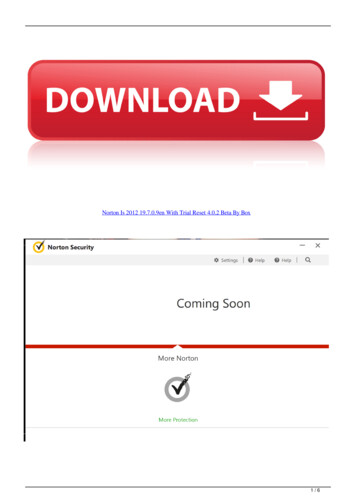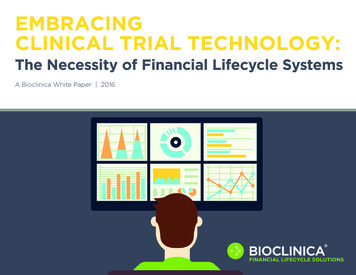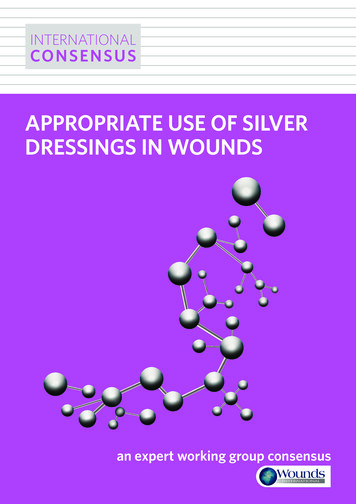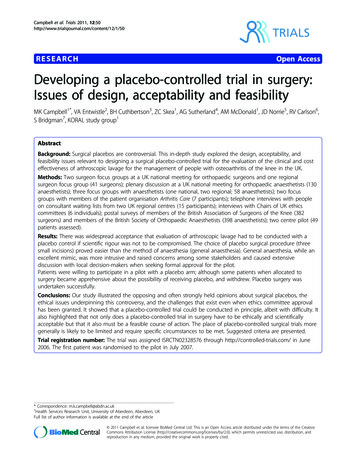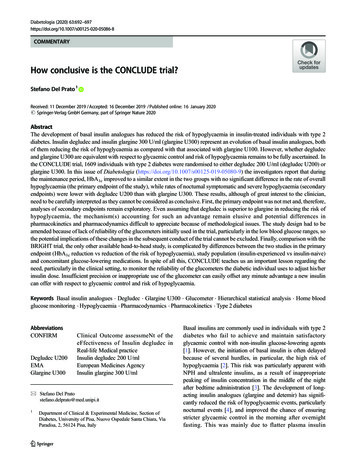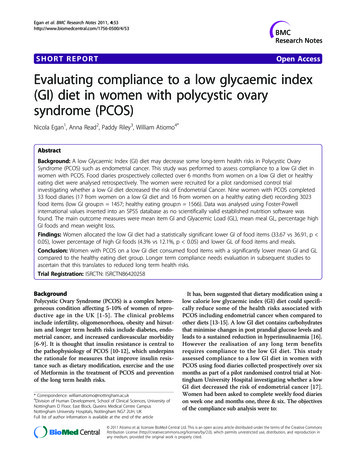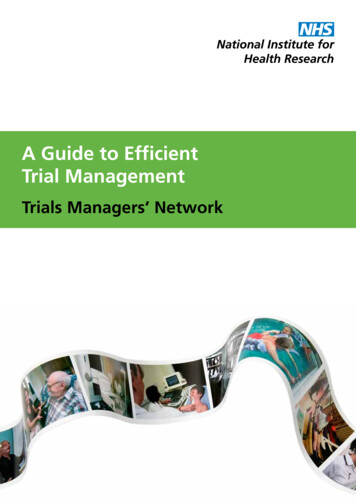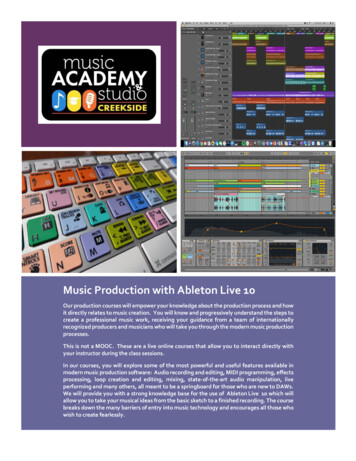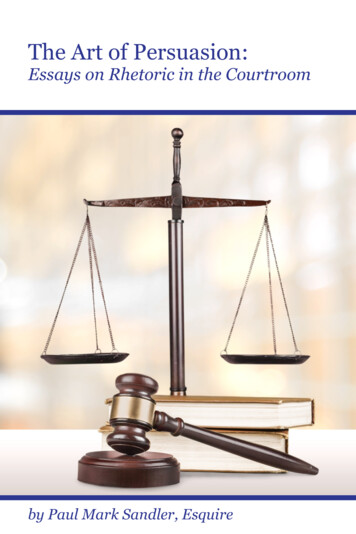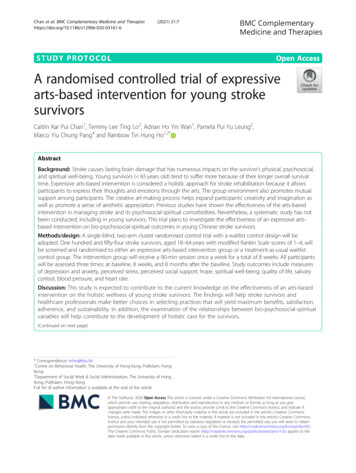
Transcription
Chan et al. BMC Complementary Medicine and 6(2021) 21:7BMC ComplementaryMedicine and TherapiesSTUDY PROTOCOLOpen AccessA randomised controlled trial of expressivearts-based intervention for young strokesurvivorsCaitlin Kar Pui Chan1, Temmy Lee Ting Lo2, Adrian Ho Yin Wan1, Pamela Pui Yu Leung3,Marco Yiu Chung Pang4 and Rainbow Tin Hung Ho1,2*AbstractBackground: Stroke causes lasting brain damage that has numerous impacts on the survivor’s physical, psychosocial,and spiritual well-being. Young survivors ( 65 years old) tend to suffer more because of their longer overall survivaltime. Expressive arts-based intervention is considered a holistic approach for stroke rehabilitation because it allowsparticipants to express their thoughts and emotions through the arts. The group environment also promotes mutualsupport among participants. The creative art-making process helps expand participants’ creativity and imagination aswell as promote a sense of aesthetic appreciation. Previous studies have shown the effectiveness of the arts-basedintervention in managing stroke and its psychosocial-spiritual comorbidities. Nevertheless, a systematic study has notbeen conducted, including in young survivors. This trial plans to investigate the effectiveness of an expressive artsbased intervention on bio-psychosocial-spiritual outcomes in young Chinese stroke survivors.Methods/design: A single-blind, two-arm cluster randomised control trial with a waitlist control design will beadopted. One hundred and fifty-four stroke survivors, aged 18–64 years with modified Rankin Scale scores of 1–4, willbe screened and randomised to either an expressive arts-based intervention group or a treatment-as-usual waitlistcontrol group. The intervention group will receive a 90-min session once a week for a total of 8 weeks. All participantswill be assessed three times: at baseline, 8 weeks, and 8 months after the baseline. Study outcomes include measuresof depression and anxiety, perceived stress, perceived social support, hope, spiritual well-being, quality of life, salivarycortisol, blood pressure, and heart rate.Discussion: This study is expected to contribute to the current knowledge on the effectiveness of an arts-basedintervention on the holistic wellness of young stroke survivors. The findings will help stroke survivors andhealthcare professionals make better choices in selecting practices that will yield maximum benefits, satisfaction,adherence, and sustainability. In addition, the examination of the relationships between bio-psychosocial-spiritualvariables will help contribute to the development of holistic care for the survivors.(Continued on next page)* Correspondence: tinho@hku.hk1Centre on Behavioral Health, The University of Hong Kong, Pokfulam, HongKong2Department of Social Work & Social Administration, The University of HongKong, Pokfulam, Hong KongFull list of author information is available at the end of the article The Author(s). 2020 Open Access This article is licensed under a Creative Commons Attribution 4.0 International License,which permits use, sharing, adaptation, distribution and reproduction in any medium or format, as long as you giveappropriate credit to the original author(s) and the source, provide a link to the Creative Commons licence, and indicate ifchanges were made. The images or other third party material in this article are included in the article's Creative Commonslicence, unless indicated otherwise in a credit line to the material. If material is not included in the article's Creative Commonslicence and your intended use is not permitted by statutory regulation or exceeds the permitted use, you will need to obtainpermission directly from the copyright holder. To view a copy of this licence, visit http://creativecommons.org/licenses/by/4.0/.The Creative Commons Public Domain Dedication waiver ) applies to thedata made available in this article, unless otherwise stated in a credit line to the data.
Chan et al. BMC Complementary Medicine and Therapies(2021) 21:7Page 2 of 10(Continued from previous page)Trial registration: ClinicalTrials.gov, NCT03729648. Registered 31 October 2018 - Retrospectively registered, (329words)Keywords: Young stroke survivors, Expressive arts-based intervention, Holistic approach, Stroke rehabilitation,Salivary cortisolBackgroundStroke causes lasting brain damage that impairs severalbody functions, resulting in restrictions in all aspects oflife [1]. It does not merely affect one’s independence butalso one’s psychosocial well-being and quality of life [2–11]. Young stroke survivors ( 65 years old) are more likelyto suffer to a greater extent than their older counterpartsbecause of their longer overall survival time. They oftenreport unmet psychosocial-spiritual needs [7, 10, 12–18].To help young stroke survivors address their uniquepsychosocial-spiritual concerns, which have been found tobe crucial for rehabilitation adherence and achievingfavourable recovery outcomes [11, 19], there is a need fora holistic rehabilitation programme, particularly the nonpharmacological one, as an adjuvant to conventional physical and occupational rehabilitation to buffer against mental health issues, reduce psychosocial stress, resume socialconnections, and re-instill hope [6, 8, 20–25].The need for a holistic, arts-based approach for therehabilitation of young stroke survivorsArts-based intervention refers to the application of thearts making process in a healthcare setting to deliver anovel and creative experience for therapeutic purposes[26]. The therapeutic use of arts has been considered asa way to promote holistic wellness [27]. During theprocess, the use of different art modalities (e.g. music,dance, visual art, drama, writing, etc.) may stimulate different parts of the brain (e.g. visual, auditory, tactile,etc.) [28]. Also, the multi-sensory stimulations createdby the colours, shapes, textures, patterns of tone andrhythm, and quality of body movements and gestures,etc. would play an important role in facilitating emotional expression, abstract thinking, and/or personal reflection [29]. Through exploring the relationshipbetween these bodily sensations and one’s thoughts andfeelings, the person may uncover strengths, gain insight,and reclaim aspects of self-identity and worthiness of life[30]. Moreover, creating arts contributes to feelings ofautonomy and dignity when other aspects of life seemout of control [31]. It also allows survivors to move awayfrom illness-related preoccupations and derive greatersatisfaction and self-esteem as they witness the quality oftheir artwork and gain positive feedback from others[32]. The non-verbal communication and symbolic expression through art media during the art-makingprocess can further enhance engagement and help express feelings or thoughts that are difficult to verbalize.An expressive arts-based intervention is uniquelyequipped to take advantage of utilising all art modalities,such as visual art, music, dance/movement, drama, andwriting [33], to address the psychosocial-spiritual needsof stroke survivors [18]. Nevertheless, systematic research on its effectiveness is still limited, including onyoung survivors [27, 34, 35].Salivary cortisol levels and strokeSalivary cortisol is a stress biomarker and an objectivemeasure of psychological stress that reflects the functioning of the hypothalamic-pituitary-adrenal axis. A previousstudy showed that cortisol levels were elevated in patientswho had undergone more severe strokes, and such distortion in the diurnal cortisol profile is linked with a longerhospital stay for inpatients, higher dependency, and agreater risk of depression and delirium in outpatientstroke survivors [36]. Given the important implications ofpsychological distress and elevated cortisol levels onstroke severity and rehabilitation outcome, it is importantto examine the changes in psychological distress and cortisol profiles during the rehabilitation period.Research objectivesThe proposed study will primarily examine the effectiveness of an expressive arts-based intervention on biopsychosocial-spiritual outcomes in young Chinese strokesurvivors in comparison with the outcomes in thetreatment-as-usual control group across different timepoints. It will also explore the associations between thepsychosocial-spiritual variables and cortisol profiles as wellas the changes in those associations across time. Moreover, participants’ nature of ischaemic or haemorrhagicstroke will be accounted for using statistical methods toexplore the common and differential effects of the expressive arts-based intervention on both types of stroke.Methods/designResearch designThe study will adopt a single-blind, two-arm cluster randomised control trial design with treatment-as-usualcontrol. It will comprise an eight-week interventionphase and a six-month maintenance phase. The biopsychosocial-spiritual well-being of participants will be
Chan et al. BMC Complementary Medicine and Therapies(2021) 21:7assessed three times: at baseline (T0), 2 months after thebaseline (post-intervention, T1), and 8 months after thebaseline (T2) (see Fig. 1). The study design, adhering toCONSORT guidelines, is summarised in Fig. 2.Participant eligibility and recruitmentParticipants will be recruited via referrals from public hospitals, Community Rehabilitation Network (CRN), Community Rehabilitation Day Centres (CRDC), and PatientSelf-help Groups in Hong Kong, Department of Rehabilitation Sciences of The Hong Kong Polytechnic University,and Faculty of Education (Division of Speech and HearingSciences) of the University of Hong Kong. Promotionalmaterials will also be delivered through social media andnewspapers. A modified Rankin Scale (mRS) assessmentwill be performed by a trained research coordinator toscreen for non-bedridden survivors who are living withpost-stroke symptoms (mRS scores of 1–4). Informedconsent will be obtained from the eligible participantswho fulfil the inclusion and exclusion criteria.Inclusion criteria– Presence of a single-lesion stroke in the left or right,temporal, frontal, parietal, or subcortical brainregionPage 3 of 10– Experience of a major stroke event within the last60 months from the time of study participation– Diagnosis of either (a) ischaemic or (b)haemorrhagic stroke– Disability grade 1 to 4 on mRS– Residual function of the affected extremity– Ability to understand instructions, both verbal andwritten, in Chinese– Aged 18–64 yearsExclusion criteria– Concurrent diagnosis of major medical orpsychiatric disorders other than stroke– Currently receiving hospital treatment and care– Presence of hearing or visual deficits, even with aids– Total paralysis of the upper limbs– Amputation of one of the limbsRandomisation and stratificationThe consenting participants will be randomised into anexpressive arts-based intervention group or a treatmentas-usual control group on a 1:1 basis. The randomisationwill be stratified by sex and degree of disability to balance the covariate effect across the two arms. Each participant will be assigned a computer-generated, randomFig. 1 Schedule of enrolment, interventions, and assessments. *EABI: Expressive arts-based intervention
Chan et al. BMC Complementary Medicine and Therapies(2021) 21:7Page 4 of 10Fig. 2 CONSORT diagram of the intervention and waitlist control groups and data collection pointsnon-repeating number (from 1 to 200). They will thenbe ascendingly sorted into each cluster with the top halfof the list (small numbers) being assigned to the intervention group and the rest being assigned to the controlgroup.InterventionBesides routine healthcare and rehabilitation services,the intervention group will receive an expressive artsbased intervention that consists of eight 90-min sessions,once per week with a total of 12 contact hours. Theintervention will be delivered at the Centre on Behavioral Health, The University of Hong Kong, and theCRDC, in a small group format of 6–8 participants. Aregistered expressive arts therapist will be recruited toconduct all the intervention groups after receiving training from the Principle Investigator (PI) of the project(corresponding author). Treatment fidelity and qualitywill also be monitored by the PI in the form of regularon-site and off-site supervision throughout the project.The structure and content of the intervention (seeTable 1) are informed by the literature on arts-based interventions and the holistic needs of various Chineseclinical populations [37–39]. Different concepts regarding psychosocial-spiritual well-being (e.g. body-mindconnection, resilience, stress, and hardship in life,
Chan et al. BMC Complementary Medicine and Therapies(2021) 21:7Page 5 of 10Table 1 Structure, themes and objectives of the interventionPhasesThemesObjectivesPhase 1: Empowerment and rapportbuildingSession 1: Greetings andImagination- Build up relationships and enhance imagination through artsSession 2: Body-mindconnection- Raise awareness on body-mind connectionSession 3: Creativity- Enhance capacity and flexibility for problem-solving through the use ofcreativitySession 4: Body senses- Facilitate emotional awareness and expression through bodily felt sensesPhase 2: Resilience strengtheningPhase 3: Consolidation and hoperestorationSession 5: Stress in daily life- Release and transform stress in daily lifeSession 6: Adversities in life- Allow expression and transformation of feelings in relation to the challengescaused by strokeSession 7: Treasures in life- Identify key resources sustaining them throughout the course of recoverySession 8: Review andcelebration- Review and consolidate the group experience- Celebration and farewellinternal and external resources, and hope) will be explored and discussed in different sessions. Each sessionwill be started by greeting the participants and introducing the session theme. Somatic exercises will be used towarm-up the participants physically and psychologically.Subsequently, the participants will be guided to engagein an art creation process, which aims to facilitate theexpression of their thoughts and feelings in relation tothe specific theme of the session. After that, they will beencouraged to share their artworks and art-making experiences. By articulating the relationships between thearts, the creative process, and the situations encounteredin real life, the participants may develop a deeper understanding of self as well as new insights. The session willbe ended with a closing ritual to consolidate experiencesand build group cohesion. To cater to the participants’different degrees of disability, activities will be performedin standing or sitting positions as per need. The structure of each session will be kept similar, but the contentwill be appropriately adjusted to suit the immediateneeds and dynamics of the group.The treatment-as-usual control group will continue withroutine healthcare and rehabilitation services. They will begiven the option to participate in the expressive arts-basedintervention after the eight-month study period.including (a) psychosocial and spiritual well-being, (b)stroke-related quality of life, (c) physiological biomarkers, and (d) demographics and clinical details. mRS,blood pressure, and heart rate will be assessed by the research coordinator. Other measures will be completedby the participants themselves at all study time points.To promote participant retention, cash coupons will begiven to participants who complete all the evaluationexercises.BlindingPerceived stress Perceived stress will be assessed by theChinese Perceived Stress Scale [42]. Using a 5-pointLikert scale (0–4), the scale consists of 10 items aboutthe degree to which life events are appraised as stressful.Owing to the nature of the trial, the participants andtherapist cannot be blinded to the allocation. The dataanalyst and the researcher who will conduct the laboratory assessment will be blinded by recoding the demographic and group information during the process ofdata entry.Study outcomesMeasures of the study outcomes pertain to areas of biopsycho-social-spiritual well-being of stroke survivors,Screening instrumentDisability mRS is a clinician-reported rating scale formeasuring the degree of disability of stroke patients. Thescale is rated on an ordinal scale of 0 to 6 with a higherscore denoting a higher level of post-stroke disability [40].Psychosocial assessmentsDepression and anxiety The Chinese version of theHospital Anxiety and Depression Scale [41] will be usedto capture the anxiety and depressive symptoms. The 14item, 4-point scale measures anxiety (7 items) and depression (7 items) subscales. The measure will be used as anoutcome measure on mental health distress across time.Perceived social support Perceived social support willbe captured by the Chinese version of the Multidimensional Scale of Perceived Social Support [43]. The 12item scale is composed of subscales for perceived socialsupport from the family, friends, and significant othersrated on a 7-point Likert scale.
Chan et al. BMC Complementary Medicine and Therapies(2021) 21:7Spirituality well-being assessmentsHope The Chinese version of the Adult State HopeScale [44] will be used to measure hope. The 6-itemscale, rated on an 8-point scale, yields an aggregate scoreof hope as well as the agency and pathway subscales.Spiritual well-being Participants’ intention to findpeace and to take care of their own spiritual needs willbe measured by the 3-item spiritual care subscale of theBody-Mind-Spirit Holistic Well-being Scale rated on an11-point anchored scale. The scale measures differentdimensions of subjective well-being in the context of afflictions and equanimity [45].Quality of life assessmentsStroke-specific quality of life The Chinese version ofthe Stroke-specific Quality of Life (SS-QoL-CH) [46],Short Form is a 12-item disease-specific health-relatedquality of life measure widely applied in stroke research.The scale yields two quality of life subscales in physicaland psychosocial components rated on a 5-point scale.Health-related quality of life The Chinese 12-itemShort Form (SF-12) Health Survey [47] will be used tomeasure the health-related quality of life on the dimensions of physical and emotional well-being.BiomarkerSalivary Cortisol Saliva samples will be collected at fiveprescribed time points (awakening, 45 min postawakening, noon, 5 pm, and 9 pm) using the Salivette kit(Sarstedt; Nümbrecht), which includes a cotton swab toplace under the tongue. A trained research coordinatorwith prior experience in using the kit will explain thecollection procedures to the participants in detail. A record sheet will also be included in the package to document the participants’ health behaviours and activitieson the day of saliva collection that might affect the diurnal cortisol rhythm, including (a) smoking habit, (b)consumption of alcohol/coffee on that day, and (c) subjective evaluation of sleep quality, total sleep duration,and stress levels on a scale of 1 to 10. All of these measures may affect the diurnal cortisol rhythm and will becontrolled in the analysis.Blood pressure and heart rate Blood pressure andheart rates will be taken following the guidelines of theCanadian Medical Association [48]. They will offer basicinformation on the health condition of the cardiovascular system, e.g. hypertension situation of the participants,which may relate to the risk of stroke. The parametersPage 6 of 10will be measured twice from each arm with a 5-min restinterval between measurements. The collected readingswill be averaged.Socio-demographic and clinical informationDemographics Socio-demographics, such as age, gender, education level, employment and financial status,and marital status, will be documented based on selfreport questionnaires.Clinical data Participants’ clinical profiles, includingtypes of stroke, time-lapse from the first occurrence, onset and history of psychiatric disturbance, presence ofcomorbidity if any (such as physical disabilities, hypertension, diabetes mellitus, or any other form of vasculardisease), treatment and medication record, and psychosocial support and/or rehabilitation service utilisationwill be documented.Data safety and monitoring boardThe General Research Fund of the Research GrantsCouncil and the Institutional Review Board will monitorthe safety and progress of the study. Progress reportswill be submitted to these two institutes at 18- and 12month intervals, respectively.Data managementData will be entered into a database immediately afterdata collection from each participant at each time pointby the research coordinator. Upon the completion ofdata entry, data screening will be conducted by the dataanalyst. Any invalid input will be double-checked and/orre-entered by another research team member to ensurethe data is reliable and valid for later analysis.Sample size estimatesTo achieve a statistical power of 80% with a medium effectsize (Cohen’s d 0.63) at a significance level of 0.05 in regression modelling (latent growth modelling) under theproposed two-arm, three-time point design, a sample sizeof 116 is needed according to Monte Carlo simulation.Assuming an attrition rate of 25% based on prior trials ofarts-based therapies in stroke survivors [49], a total of 154participants will be required (i.e. 77 per arm).Statistical analysesExploring the effectiveness of expressive arts-basedinterventionIntention-to-treat analysis will be used to maintain theprognostic balance resulting from randomisation. Fullinformation maximum likelihood will be conducted toestimate the missing data. Analysis of variance and Chisquare independence tests will be performed using the
Chan et al. BMC Complementary Medicine and Therapies(2021) 21:7Statistical Package for Social Sciences (SPSS) (IBM; NewYork) to compare the demographic profile of the twogroups. Latent growth modelling in Mplus will be usedto explore the effectiveness of the intervention over theassessment points and in comparison to the controltreatment.Analysis of salivary cortisolSaliva samples will be centrifuged at 3000 rpm for 15min at room temperature. The concentration of cortisolin each sample will be calculated using the SalimetricsSalivary Cortisol ELISA kit (Salimetrics, LLC; Carlsbad).The assay sensitivity is 0.193 nmol/L, and the intra- andinter-assay coefficients of variation are 3 and 10%, respectively. The mean cortisol level across the day, thetotal cortisol level indexed by the area under the curve,and the diurnal cortisol slope will be calculated.To explore individual trajectories of changes in cortisol levels over time and the complex relationships between different variables, a two-level individual growthcurve model using Mplus software will be adopted ascortisol measures at five daily time points are nestedwithin the participants. The method is an appropriatevariant of multiple regression modelling for the nestedstructure of cortisol data.Common and differential effects of the intervention onischaemic and haemorrhagic stroke survivorsTo explore the potential differential effects of the intervention on ischaemic and haemorrhagic stroke survivors,treatment effects on the two groups will be directly compared in multi-group conditional growth models.Study organisation and fundingThe study is funded by the General Research Fund ofthe Research Grants Council (GRF/HKU/17609417).The trial and the expressive arts-based intervention willbe coordinated and conducted by the Centre on Behavioral Health, the University of Hong Kong.DiscussionStroke rehabilitation is a race against time. The clinicalpopularity of the use of the arts in stroke rehabilitationcalls for the need for rigorous research evidence on theirbenefits. Nevertheless, a systematic study related to artsbased intervention has not yet been conducted, including among younger stroke survivors, who may experience greater and longer-term impacts in the psychophysiological and social-spiritual aspects. This study isexpected to contribute to the current knowledge on theeffectiveness of arts-based rehabilitation on young strokesurvivors. Both psychological and physiological outcomes will be examined for a comprehensive understanding of the biological, psychological, social, andPage 7 of 10spiritual changes after participating in a nonpharmacological, engaging, safe, and enjoyable multimodal expressive arts-based intervention for rehabilitation. The findings will help stroke survivors and healthcare professionals make better choices in selectingpractices that will yield maximum benefits, satisfaction,adherence, and sustainability for young stroke survivors.In addition, the examination of the relationships between bio-psychosocial-spiritual variables may helpunderstand the complex relationships between these factors after stroke and during rehabilitation, which willcontribute to the development of holistic care for thesurvivors.Ethics and disseminationResearch ethics approvalThe safety and ethical conformity of the study have beenreviewed and approved by the Human Research EthicsCommittee of the University of Hong Kong (EA1702058)and the Institutional Review Board of the University ofHong Kong/Hospital Authority Hong Kong West Cluster(UW18–467) and East Cluster (HKECREC-2019-111).The study is also registered with the ClinicalTrials.govRegistry (NCT03729648).Protocol amendmentsAmendments to the protocol, including changes to inclusion criteria, recruitment, or data collection procedures, will be agreed upon by the principal investigatorand approved by the Human Research Ethics Committeeof the University of Hong Kong, the Institutional ReviewBoard of the Hospital Authority, and ClinicalTrials.govbefore implementation.ConsentThe study details and requirements will be fully described and explained to the eligible participants by a research coordinator before obtaining informed consentfrom them (see Appendix I).ConfidentialityAny information obtained in this study will remainstrictly confidential and be used for research purposesonly. Codes, not names, are used on all reports and publications related to this study to protect confidentiality.All collected questionnaires will be kept in locked cabinets and saliva samples will be stored at a locked laboratory freezer in the Centre on Behavioral Health at theUniversity of Hong Kong. The electronic dataset will bestored in encrypted computer storage. Data containingpersonal identifiers will be kept for a maximum of 3years after the publication of the first paper upon theend of the study.
Chan et al. BMC Complementary Medicine and Therapies(2021) 21:7Declaration of interestsThe authors declare that there is no conflict of interestregarding the publication of this protocol.Access to dataOnly the research team members of this project willhave access to the data.Ancillary and post-trial careThere are no provisions for ancillary or post-trial care.Dissemination policyManuscripts resulting from this trial will be published inacademic journals and/or abstracts of papers will be presented in academic conferences. Authorship eligibilityincludes (1) substantial contributions to the study designor the process of data acquisition, analysis, or interpretation, (2) drafting or revising the manuscript, and (3) approving the final manuscript. There is no intention touse professional writers.AppendixDepartment of Social Work and Social Administration, The University of Hong Kong.Centre on Behavioral Health, The University ofHong Kong.The Psycho-physiological & Social-Spiritual Effectsof Expressive Arts-based Intervention on Young andPre-elderly Stroke Survivors: A Randomized Controlled Study.Informed Consent Form.Evidence has emerged to support the effectiveness ofdifferent arts modalities in improving the psychophysiological and social-spiritual well-being of youngand pre-elderly stroke survivors. You are invited to participate in a research study conducted by Prof. RainbowT.H. Ho, of the Department of Social Work and SocialAdministration, The University of Hong Kong, andCentre on Behavioral Health (The University of HongKong). The primary purpose of the research is to investigate the short and long-term psycho-physiological andsocial-spiritual effects of an Expressive Arts-based Intervention on younger and pre-elderly Chinese strokesurvivors.Research Procedures.All eligible participants will be randomly assigned toeither the Expressive Arts-based Intervention Group orthe Treatment-As-Usual Control Group upon screeningfor inclusion-exclusion criteria. You will be invited tocomplete an assessment package (including questionnaires and a two-day saliva cortisol kit) at 3 time pointsincluding the baseline, post-intervention (8-week timepoint), and at 6-month post-intervention. Participants inthe Expressive Arts-based Intervention Group willPage 8 of 10receive an 8-week expressive arts-based program (8 sessions, 90 min per session) provided by a trained expressive arts therapist, while the participants in the controlgroup will continue with routine healthcare services, andthey will be given the option to take part in the sameintervention program upon completion of the 6-monthpost-intervention follow-up assessment. Some of theparticipants will also be invited to join a 45 min in-depthinterview at post-intervention (8-week time point), andat 6-month post-intervention. The interview will focuson the changes after the onset of stroke and the experiences of participating in the Expressive Arts-based Intervention Group. The interview will be audio-recorded fordata analysis. All data obtained during the study will remain strictly confidential; and all personal identifying information will be erased from the database 3 years afterthe first publication from this study.Potential Risks/ Discomforts and their Min
Keywords: Young stroke survivors, Expressive arts-based intervention, Holistic approach, Stroke rehabilitation, Salivary cortisol Background Stroke causes lasting brain damage that impairs several body functions, resulting in restrictions in all aspects of l
